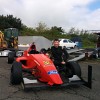andylaurence wrote:xxChrisxx wrote:andylaurence wrote:CFD is hard for an amateur to get configured and running, so having a site to upload a file and have it processed is brilliant.
GIGO
Thanks for that considered constructive analysis. Garbage isn't an on/off situation. There's ideal (nothing is) and varying degrees from that. An F1 team might be looking at 0.1mm accuracy on their aero parts, but that's not true of club racing. There's a lot to learn from basic analysis. People still use 2D analysis to break down to which wing profile is most appropriate in a situation. Bear in mind that the target audience for this product is people whose cars were designed by a bloke in a garage with a pencil, not international race teams. Picking a direction is much easier with reduced accuracy when a simple change could lop half a second off your lap time, rather than the tiny increments a top level team would be looking at.
You haven't done any CFD before have you? My issue isn't with the geometry.
This is a black box job. You put a model in, and get some pretty pictures out.
The first and most obvious question is: How do you know that what they have produced isn't a load of ---?
(put more nicely, how do your know their assumptions are in any way valid)
How do we know that their mesh is of any sort of quality?
How do you know they have decent boundary conditions?
How do you know that their turbulence model is suitable?
Are they running a suitable near wall model?
etc, etc, etc
With a model that takes 2 days from geometry to report that costs a few quid. You aren't getting a job that had involved any sort of thought. The results are nothing more than pictures with lines on.
As a more basic example:
You come to me asking me to calculate the area of your circle of radius 1. I stick it in my black box area-o-meter. The answer comes out as 3. Becucase I assumed pi = 3.
It's perfectly valid calculation, but the assumption is too far out to be considered useful.
This is simple enough to see where it's gone wrong. When assuming many many variables, it gets a little muddier.
The amateur would learn more about his car by sicking wool tufts to the surface and taking some photos.


